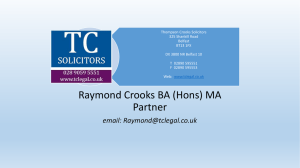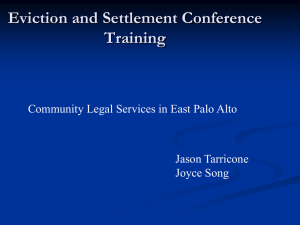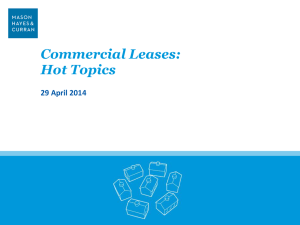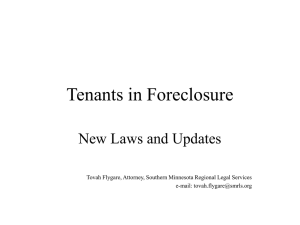Real Property
advertisement
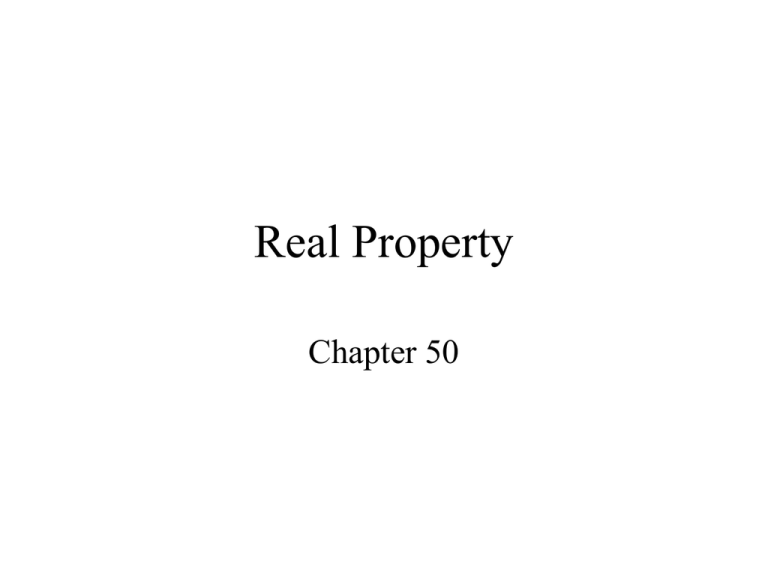
Real Property Chapter 50 Freehold Estates • Fee Simple absolute • Fee Simple Determinable (Qualified Fee) • Life Estates – Per autre vie Fee Simple Absolute • Absolute: Runs forever; no restraints ; largest estate permitted by law; holder can sell, divide, devise, inherit; presumed fee simple unless language shows intent to create something else – A to B, creates fee simple in B, no correlative future interest in a third party – To A and his heirs, creates fee simple in A Fee Simple Determinable • A qualified fee • Automatically terminates upon the happening of a stated event and goes back to the grantor, who retains a “possibility of reverter” as a future interest … for so long as, until, while, during… – O conveys land “to A for so long as no alcoholic beverages are consumed on the premises.” This gives A a fee simple, because the estate may last forever if no one ever quaffs a brew. A can convey his fee simple determinable to B, B will own the “for so long as” estate. If A does not convey his estate, on A’s death it will pass by will or intestacy to his successors. If, however, someone consumes alcoholic beverages, the estate automatically comes to an end according to its own terms and O will immediately and automatically become the owner of the fee simple (or O’s heirs) Life Estate • Usually measured by the life of the grantee. Ends when life tenant dies. Person who conveys may have a reversion. • Some life estates have a remainderman – A conveys “to B for life”. B has a life estate, on his death, land reverts to A (or successors) – To A for the life of B (per autre vie) – To A for life, then to B (remainder) – Contingent Remainder – Remainder is contingent if a condition must be satisfied before grantee can be certain of possession: O to A for life, then to B and his heirs if B is 21 on A’s death. B has a contingent remainder, O has a reversion; O conveys land in fee simple to B for life, and on B’s death to C if C survives B. B has a life estate, C has a contingent remainder and O has a reversion that will take in present possession at B’s death if C predeceases B. Also, if you can’t identify by name the person who holds the remainder, the remainder is contingent: O to A for life, then to A’s widow. A is married to B. A’s widow has a contingent remainder because the widow can’t be identified until husband dies. A has a life estate and could remarry someone other than B. Vested Remainders • Vested Remainder – Can be created in and held only by an ascertained person in being – Must be certain to become possessory (there is no condition that may operate to prevent the remainder from someday being a present interest) – To A for life, and on A’s death to B. A has a life estate, B has a vested remainder which is certain to take place when A dies. If B dies during A’s lifetime, B’s remainder passes to his successors. • Vested Remainder Subject to Open • A vested remainder may be created in a class of persons (children, brothers, sisters) that is certain to take on the termination of the life estate but whose members are not yet fully known. • O to A for life, then to A’s children. A has three children, B,C,& D. O has NOTHING; A has a life estate and B,C & D have vested remainders subject to open. Waste • The life tenant only has a duty to maintain the estate and that means continuing the normal use of the land in its present condition. • If the life tenant does more or less, he may be guilty of waste. Waste • Voluntary – Life Tenant can’t take affirmative action beyond the right of maintenance; may only continue normal use, any change of use is voluntary waste (if land is farm land, just farm it) Don’t deplete natural resources. • Permissive waste – where tenant has failed to maintain, inaction. Tenant must avoid permissive waste by making ordinary repairs, no need to replace. Life tenant pays all taxes and interest on mortgage; remainder man pays on the principal. • Ameliorative – A special waste when affirmative action alters the property but increases the value to it. If changed conditions have made property relatively worthless in its current use, life tenant may tear it down without liability to An old residential mansion is now surrounded by heavy industry. Life tenant wants to tear down the mansion, making the underlying land much more valuable for other uses. Probably can tear it down, even if holder of future interest objects.. Duties of Tenant • Pay Rent • Not commit Waste • Not obliged to make repairs, unless lease says otherwise Landlord’s Duties • To give Tenant possession of the premises when lease begins • To deliver residential premises in a habitable condition (implied warranty of habitability). If LL breaches implied warranty, Tenant has two options: (1) T can move out and end lease; (2) stay and sue for damages. If uninhabitable, “constructive eviction”. • Implied covenant of quiet enjoyment (not to interfere with tenant’s right of possession, i.e., not change the locks and lock Tenant out of basement) Tenant could abandon premises and terminate lease. Landlord’s Tort Liability • At Common Law, ______________ of landlord to Tenant or to Tenant;s invitees for injuries on the premises during the life of the lease. • 4 Situations where LL is LIABLE • 1. Latent defects – L is under a duty to ____________ latent defects which either L knows or has reason to know of. – LL leased a house to Tenant; the house has wooden stairs that lead to an elevated porch. The steps have a hidden defect; they are rotten. There is no evidence that the landlord knew of the defect but landlord had painted the steps the week before renting to tenant. One day tenant is using the steps and they collapse, seriously injuring Tenant. Is LL liable? ________________ – Latent defect is defect the Tenant does not know of ands a reasonable person in Tenant’s position would not_____________. Landlord’s Tort Liability Continued • 2. Short Term lease of a furnished dwelling. LL is liable for defects even if LL neither _________ nor has ___________________ to know of them. – Tenant rented a furnished two story condo in Ft. Myers for a short term. The wooden steps were rotten; tenant was seriously injured. LL lived up north, and hadn’t been to Ft. Myers in 10 years. LL neither knew or had reason to know the steps were rotten. Is LL liable? ___________. – Short Term ___________ months or less. LL’s Tort Liability – Con’t • 3. Common areas under Landlord’s control – If injury is in an area subject to LL’s control then LL is liable if LL failed to use reasonable care. – Tenant was walking down the hallway on the fifth floor of Desperate Towers, a high rise apartment building. Tenant slipped on a loose tile and was seriously injured. Is LL liable? _____________________ LL’s Tort Liability – Con’t • Negligent repairs – LL is liable for injury resulting from LL’s repair of a defect in the premises, even if LL used all due care in making the repair. – Tenant complained to LL of plaster flecking from the ceiling. LL replastered ceiling using all due care. That night the entire ceiling collapased onto tenant’s bed. Is LL liable? – _____________ Commercial Tenant’s Tort Liability to Third Parties • Tenant is always liable to third party invitees for negligent failure to correct dangerous conditions on the premises, regardless of whether LL may be contractually liable or not!!! – LL leased commercial property to tenant – a store front. One day tenant was out in front of the store and noticed a loose tile on a step leading into the store. Tenant was concerned that a customer might trip on the tile, so tenant called landlord and said “You promised to repair, come fix it.” The LL promised to do so but did nothing. Tenant called several times, but LL did not repair it. Finally, a customer slipped on the loose tile, was injured, and sued Tenant. Is Tenant liable? ______ because of tenant’s ___________ in not fixing the tile. Non-Freehold (Landlord Tenant) Estates • Tenancy for Definite Term (a.k.a. Tenanvy for Years) • Periodic Tenancy • Tenancy at Will • Tenancy at Sufferance Definite Term • KEY PHRASE is to remember is : ___________________. – does not have to be for years. • Jeff transferred the farm to Tonya for a period from June 1 1994 to June 5, 1994. – Tonya’s estate is a ____________________ – Any estate measured by a ______________ period of time, no matter how short, is a tenancy for years. – Statute of __________ - Any tenancy for years _______________ must be in writing. One year oral is OK; one year and a day oral is NOT. Periodic Tenancy • Key word is _______________ -- an ongoing, continuing, repetitive estate until one party gives valid notice )e.g., month to month, week to week, year to year) • Lorena leased a house to John for 4100 per month, but the lease was silent as to duration. John paid the first month’s rent. What tenancy? ____________________ • Termination of periodic tenancy occurs by giving proper notice. For valid notice: – _____________ - equal to the period. Exception: if tenancy is year to year, just 6 months’ notice is required. Tenancy at Will • Either party can terminate at any time, without ________________ • Very fragile, rarely used. • 4 Ways it may terminate • 1. ______ of either party • 2. ________ by landlord to someone else • 3. __________ by the tenant • 4. ____________ _____ ______ by landlord. Tenancy at Sufferance • A ____________ tenant who won’t leave. • LL can either – 1. Hold Tenant as a wrongdoing trespasser and sue to throw Tenant off property and recover damages for the holdover, or – 2. Impose new tenancy on Tenant • Assignments and Subleases • Assignment - When T transfers everything and holds no time back. • Sublease – When T transfers a portion of the lease period, holding some time back. – Landlord leased the farm to tenant for one year on January 1st. On April 1st, Tenant transferred the remaining interest to Tenant two. An assignment or sublease? _____________ – Landlord leased the farm to tenant for one year on January 1st. On April 1st, Tenant transferred three months to Tenant two. An assignment or sublease? _______________ – Use these rules, no matter what the parties (or problem) calls it! Assignments: Successive Tenants • First Tenant remains liable unless there is an agreement between the parties, assignee expressly assumes the obligations under the lease. (novation) • EX. Landlord leases to Tenant one. Later, Tenant one assigned to Tenant two. Tenant two does not pay. Liability of Tenant One? ____________ Tenant Two? ___________ Non-Assignment/Non-Sublease clause • “T may not assign or sublet without LL’s permission.” • Valid and enforceable? _______ • Violation of clause merely makes the attempted transfer __________ at the option of the LL and if LL does nothing, nothing happens! • Courts do enforce non-assignment clauses, but do not like them and are very quick to find a waiver. – Acceptance of rent by LL is permission, constitutes a waiver. – Once waived by LL, its waived permanently. Concurrent Ownership • 1. Joint Tenancies • 2. Tenancies in Common • 3. Tenancy by the Entireties Joint Tenancies • Two characteristics: (1) right of ______________; (2) Right to ________ • In 1968, 21 acres of the Everglades are conveyed to John, Paul, George and Ringo as joint tenants with the right to survivorship. Then in 1980, John is murdered. Now, Paul, Ringo and George each own ____________; John’s estate gets _________. • New facts: Sometime after 1968, John and Paul have a falling out and Paul’s wife, Linda, tells him to get out of the common ownership. What can Paul do? _______________ Sublease: Successive Tenants • Original tenant continues to be liable to landlord because of _____________; sublessee not liable. – LL leased the farm to student tenant for one year starting September 1st. In May, student transferred June, July, and August to tenant two. During these three months, no one pays rent to the LL. LL wants to sue Tenant two (student has graduated and moved up north). Can LL recover against Tenant two? _____________________________________ Creation of Joint Tenancy • Requires the ‘four unities” of ________, ___________, __________ and ______________. • 1. _______- - all interest must have vested at ______ ________ _________. • 2. _________ - the grant to all JT’s must have been by the same _____________. • 3. ___________ - all JT;s must take the same ________ and same ________ interest (John, Paul, George and Ringo all got ________ each) • 4. __________ - all must have ___________ rights of possession. Destruction of Joint Tenancy • A ________, a voluntary destruction, or a _________, an involuntary destruction, such as a ________________ ____________. – A ________, one JT transfers his interest, turning it into a _____________, with the other JT’s continuing to hold their interests in Joint Tenancy. EX. In 1971, Ringo deeds his ¼ interest in the Joint tenancy to a buyer. A _______ occurs, and the buyer of Ringo’s joint tenancy gets a ___________. John, Paul and George hold their interests as ___________. – A __________ may also terminate a joint tenncy. – Suppose Ringo had business problems and a creditor sought to reach his interest in joint tenancy, No severance until a ___________ _____. A creditor’s judgment lien is not enough. Tenancies-in-Common • No right of _________________. • Tenant’s have equal rights of ___________. • ____________ - Requirement that each co-tenant may have to account to another for a share of profits the cotenant received. • Co-tenants do not have a right to contribution for improvements or non-necessary repairs, but money spent can later be recouped at sale of property. – Jim and Bill own farm in Georgia as tenants in common. Jim moved to Washington; Bill did 4 things on the farm: built a house, fixed the roof of the barn, made mortgage payments, paid taxes. Does Jim have to contribute to these? – Building house (improvements) __________________ – Fixing barn (repairs) _______________ – Mortgage payments __________ – Paying taxes _______________- Tenancies in Entireties • • • • • Husband and wife ONLY Parties may not sever during marriage Divorce terminates tenancies in entireties No right to devise, sell, mortgage. No levy by creditors. Easements • KEY CONCEPT: __________________ • Definition: An easement is a non-possessory interest in land involving a right of _________. • Binding on successive landowners, irrevocable • Two types: – ____________ - when the easement directly benefits the use and enjoyment of a _______ piece of land. There are always two pieces of property, a burdened property (servient parcel) and a benefited property (dominant estate) EX. Mia owns lot A fronting on the beach. Woody owns lot B, directly behind lot A. Woody buys an easement from Mia that would allow him to walk across her lot to get to the beach. – ___________ - Where there is one piece of property, usually commercial. Ex’s: RR tracks, utility lines Creation of easements • _________ easement. Must comply with the statute of frauds. Must be executed like a deed. • Easements by _____________. Look for situations where someone sells off a piece of his property to someone else, that person fails to make a reservation of an easement, however its reasonably necessary that the previous owner continue his previous use. – EX. In January of 1993, Bill took a job on the east coast and decided to sell off part of his Arkansas farm. He sold the front half by the highway; previously he had used a road on the portion sold to get to his farmhouse on the back half of the property. Bill’s deed makes no provisions. George, new owner, refuses to recognize Bill’s right to use the road. Bill still has an n inconvenient route he could use to get to his property. Can Bill continue to use the road across the land sold to George? __________. Easement by ______________. – EX. What if Bill’s land is landlocked, and no other access to his property? Easement by ________. Easements by Prescription: Adverse Possession • Dolly and Tammy owned adjoining lots in a subdivision. Every day, for 20 years, Dolly drove over part of Tammy’s lot to get to Dolly’s garage. One day, tammy tried to fence Dolly off. Can Tammy do it? _________________ • 4 Requirements • 1. Use must be _______ • 2. Use must be ________, and ___________. • 3. Use must be __________ • 4. Use must be without owner’s ____________ Licenses • A license is a limited privilege of use and ______ a property interest, it is only a __________ right and is revocable at the will of the licensor. • Ex’s - Tickets Profits • A profit gives the right to go onto land and take a _________ _________ away (timber, coal, etc.)
